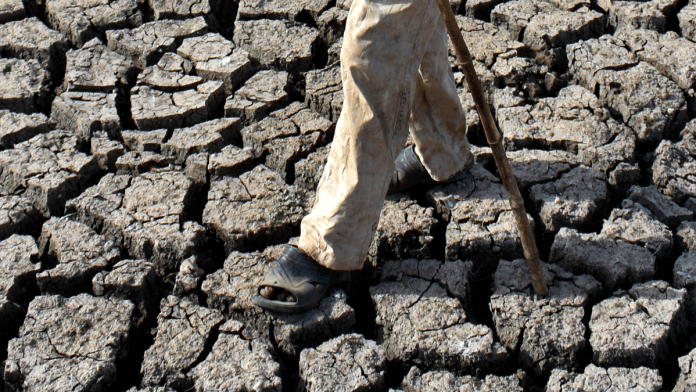Bengaluru: A sub-district (tehsil) level study of variation in monsoon patterns over the last 40 years show increase in rainfall in the traditionally drier regions of Rajasthan and Gujarat, central Maharashtra, and parts of Tamil Nadu during the southwest monsoon rain, according to the Council on Energy, Environment and Water (CEEW).
The CEEW study also found that in the same period from June to September, 11 percent of tehsils crucial to Kharif crops saw reduced rainfall in the Indo-Gangetic plains. But while rainfall increased over the majority of the country, it did not do so in a natural pattern.
Nearly 64 percent of Indian districts are experiencing an increase in the frequency of heavy rainfall days during the southwest monsoon, especially in Maharashtra, Tamil Nadu, Gujarat, and Karnataka.
The northeast monsoon (October to December) has also increased in intensity over Tamil Nadu, Andhra Pradesh, Telangana, Maharashtra, Goa, Odisha, and West Bengal.
The delayed withdrawal of the southwest monsoon from the Indian subcontinent also leads to an increase in rainfall in October, states the study. However, in the Himalayan states of Uttarakhand and Himachal, forests become extremely fire prone from November to March, with a decrease in rainfall.
“The Indian monsoons, which inherently show high variability, are now seeing even more rapid changes across seasons and geographies due to climate change. This poses significant risks to critical sectors such as agriculture, water, and energy,” author Shravan Prabhu, research analyst at CEEW, said in a statement.
“To build resilience against these evolving rainfall patterns, there is a need to mainstream local-level decision-making based on granular climate risk assessments. Our study not only maps these changes but also empowers decision-makers with open-access tehsil-level information.”
The study, conducted by CEEW and having data of 4,500-plus tehsils, is published online on their website this week.
Also Read: Why India is facing ‘driest’ August & Himalayan deluge at the same time
Agro economical implications
The agricultural sector employs over 50 percent of India’s population, and are at the mercy of the annual rainfall in India, the study said. Variability in rainfall results in changes in wet and dry conditions that have direct socioeconomic impact, describe the authors.
Changes in monsoon also lead to floods and drought, and variability trends are crucial to understand how to mitigate effects of global warming.
The study follows a number of other studies on Indian monsoon, which have identified changes in the core monsoon patterns.
It identifies the southwest monsoon as increasing the duration and intensity of rainfall over large swathes of the Indian subcontinent, with an increase of more than 10 percent in the last decade. Out of these, nearly a fourth have seen a rise in rainfall of over 30 percent.
This is particularly so in regions that tend to remain typically dry in states of Rajasthan, Gujarat, central Maharashtra, and parts of Tamil Nadu. However, rainfall in these months reduced in the northeastern parts and in the Himalayan region, as well as the Indo-Gangetic region, making up about 11 percent of the country’s tehsils.
These regions that face both excess and deficient rainfall are prime agricultural regions in India, and are expected to face the brunt of changes in climate brought about by a warming world.
Pattern of change
The increase in southwest monsoon manifests as short, rapid bursts of extremely intense and heavy rains, leading to flooding and landslides.
The study found that 31 percent of Indian tehsils experienced an increase of four or more days of heavy rainfall per year over the last ten years. For example, in 2023, Chandigarh received nearly half of its total annual rainfall in 50 hours.
The study also found that the increase in rainfall is not well distributed throughout the seasons and months. But nearly half the mapped tehsils saw an increase in October rainfall due to late withdrawal of the southwest monsoon, raising concerns for sowing Rabi crops.
Nearly all tehsils that saw a decrease in southwest monsoon over the last 40 years are located in states such as Bihar, Uttarakhand, Assam, and Meghalaya. These regions have been seeing a decline in rainfall during the initial monsoon months of June and July, which are crucial for sowing kharif crops.
On the other hand, regions with traditional rainfall have begun to experience drought. For example, Kerala encountered a near 60 per cent deficit of rain in June of last year.
Vishwas Chitale, Senior Programme Lead at CEEW and the other author of the paper, urged policymakers to take note of the changing monsoon patterns.
“As India readies for the 2024 Union Budget, it will be crucial to focus on future-proofing the economy against increasingly erratic rainfall patterns. The monsoons impact the food we eat, the water we drink and also our energy transition,” Chitale said in a statement.
“With increasing extreme weather events, hyper-local climate risk assessments and action plans are the way to go for India to keep leading in climate action and disaster risk reduction. This will help save lives, livelihoods and infrastructure.”
The study concludes that the development of district-level climate action plans, taking into consideration tehsil-level climate risk assessment data, is key to implement climate mitigation adaptation strategies across India.
(Edited by Tony Rai)
Also Read: Sriharikota, we have a problem. The ground is eroding






